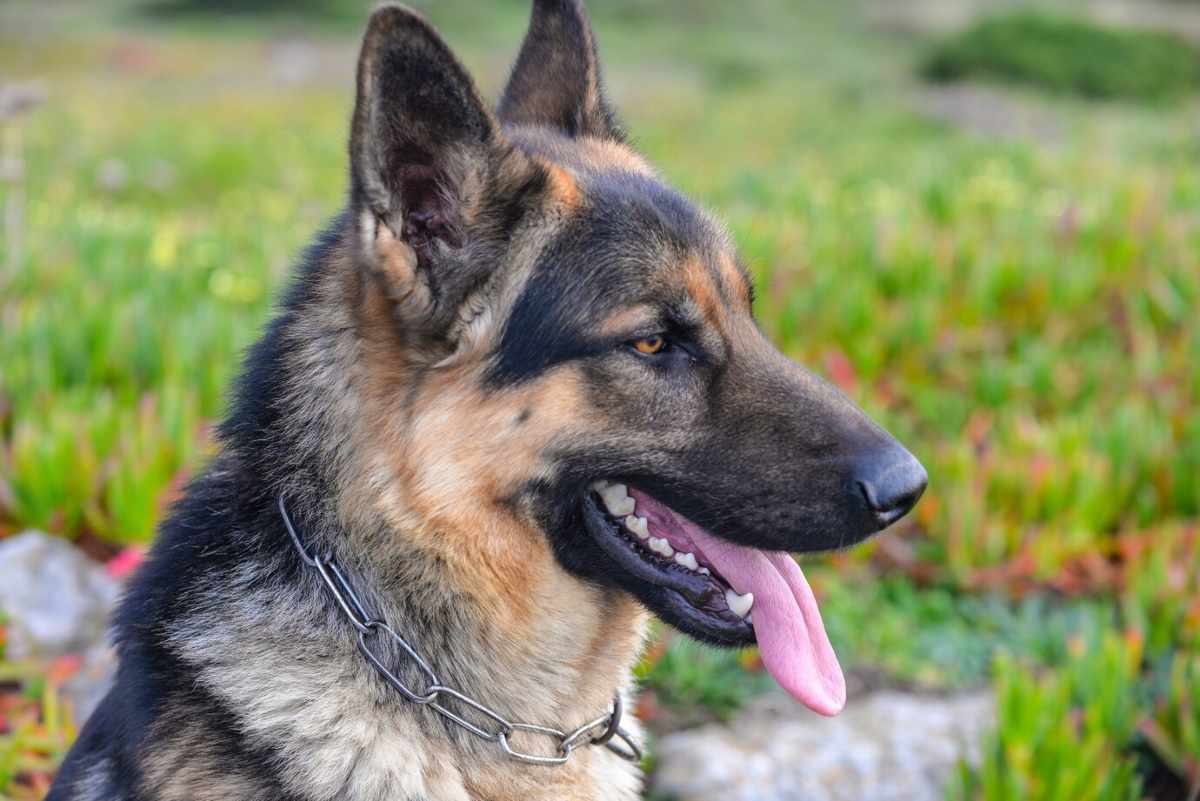The Blue German Shepherd dog breed is a captivating and rare variation of the traditional German Shepherd. Known for their striking bluish-grey coat and devoted nature, these canines have become increasingly popular among pet owners, enthusiasts, and breeders.
This comprehensive guide explores everything you need to know about the Blue German Shepherd dog breed, from appearance and temperament to health and training.

What is a Blue German Shepherd?
The Blue German Shepherd dog breed is not a separate breed but a colour variation of the standard German Shepherd. The unique blue-grey coat results from a dilution gene that affects the dog’s black pigment.
While the traditional German Shepherd is black and tan, the blue variant showcases a smoky, steel-blue hue that gives it a distinctive and elegant look.
History and Origins
German Shepherds were initially bred in Germany in the late 1800s as herding and working dogs. The Blue German Shepherd dog breed shares this lineage but emerged due to genetic dilution, a naturally occurring phenomenon. Although rare, blue German Shepherds have always been part of the breed’s genetic possibilities.
Some kennel clubs, including the American Kennel Club (AKC), consider the blue colour a fault, meaning they can’t compete in conformation shows but are still recognized as purebred German Shepherds.
Appearance and Coat Color
The most distinguishing feature of the Blue German Shepherd dog breed is, of course, its coat colour. The coat can range from a light greyish-blue to a deeper, steely shade. Some common colour variations include:
- Solid blue
- Blue and tan
- Blue sable
These dogs often have lighter eyes, typically amber or pale yellow, contrasting beautifully with their dark grey-blue coat. Their body structure is muscular and athletic, typical of German Shepherds.
Temperament and Personality
One of the reasons the Blue German Shepherd dog breed is highly sought after is its balanced temperament. These dogs are:
Loyal – They form strong bonds with their owners and are protective.
Intelligent – Among the smartest dog breeds, making them highly trainable.
Energetic – They thrive on activity and stimulation.
Alert – Excellent watchdogs with a natural guarding instinct.
Social – When properly socialized, they get along well with children and other pets.
Whether you’re looking for a working dog, a family companion, or a protective guardian, the Blue German Shepherd dog breed fits the role perfectly.
Training the Blue German Shepherd
The Blue German Shepherd dog breed is renowned for its intelligence and curiosity. This makes training relatively easy if done consistently and positively. Here are a few training tips:
Start Early: Start socialization and obedience training as early as 8 weeks.
Use Positive Reinforcement: Treats, praise, and play go a long way.
Be Consistent: Consistency helps establish clear expectations.
Provide Mental Stimulation: Puzzle toys and obedience challenges help prevent boredom.
Because the Blue German Shepherd dog breed thrives on structure and leadership, providing firm but kind guidance is essential.
Exercise and Activity Needs
German Shepherds are energetic, hardworking canines, and the Blue German Shepherd dog breed is no exception. To maintain a healthy and happy pup, you should provide:
Daily Walks: At least one hour of walking or running.
Playtime: Interactive games like fetch or tug-of-war.
Mental Stimulation: Training sessions, puzzle toys, or agility courses.
Off-leash Activities: In secure areas, they love to explore and roam.
Insufficient physical activity can result in behavioural issues, so the Blue German Shepherd dog breed needs a committed, active owner.
Grooming Requirements
The grooming needs of the Blue German Shepherd breed depend on whether the dog has a short or long coat. In general:
Brushing: 2–3 times a week to control shedding.
Bathing: Every 6–8 weeks or when dirty.
Nail Trimming: Monthly or as needed.
Ear Cleaning: Weekly, especially for active dogs.
Dental Care: Several times a week, brush your teeth to avoid plaque buildup.
Their dense double coat helps them adapt to various weather conditions, but they shed heavily, particularly during spring and fall.
Common Health Issues
While generally healthy, the Blue German Shepherd dog breed can be prone to some genetic conditions. Responsible breeders screen for the following:
Hip and Elbow Dysplasia
Degenerative Myelopathy
Bloat (Gastric Torsion)
Allergies and Skin Sensitivities
Eye Issues (due to lighter pigmentation)
A nutritious diet and routine veterinary care can help reduce these hazards. Because the blue colouration is due to a dilution gene, it may slightly increase the chance of skin sensitivities, though this is still debated among experts.
Diet and Nutrition
Feeding the Blue German Shepherd dog breed a balanced, protein-rich diet is essential to support its active lifestyle. Key dietary tips include:
High-Quality Dog Food: Choose a brand with real meat as the first ingredient.
Age-Appropriate Formulas: Puppy, adult, and senior formulas have different nutrient requirements.
Portion Control: Avoid overfeeding to prevent obesity.
Supplements: Glucosamine and omega fatty acids can support joint and coat health.
For advice on a specific diet, always speak with your veterinarian.
Living Conditions
The Blue German Shepherd dog breed does best in homes with space to move around. While they can adapt to apartment living, they need plenty of outdoor time and mental stimulation. A backyard is ideal, but regular walks and park visits can also suffice.
These dogs are not well-suited to being left alone for long hours. If bored or isolated, they may become destructive. Companion time is crucial for their mental health and overall well-being.
Breeding and Rarity
Due to their rare colouration, the Blue German Shepherd dog breed can be more expensive than standard-colored German Shepherds. Breeding for the blue coat requires two dogs carrying the recessive dilution gene.
However, ethical breeders focus on health and temperament over colour. Watch out for breeders who put appearance before genetic soundness.
Adoption and Buying Tips
If you’re considering welcoming a Blue German Shepherd dog breed into your home, here are a few tips:
Choose Reputable Breeders: Look for health screenings and ethical practices.
Consider Adoption: Some rescues specialize in rare coat colours.
Meet the Parents: This gives insight into temperament and health.
Request Health Records: Ensure the puppy has been vaccinated and checked.
Be prepared for a long-term commitment, as the Blue German Shepherd dog breed typically lives 10–13 years.
Is the Blue German Shepherd Right for You?
The Blue German Shepherd dog breed is perfect for those who lead an active lifestyle, are experienced with dogs, and have time for consistent training and bonding. These dogs thrive on companionship, challenge, and purpose.
The Blue German Shepherd breed will reward you with unmatched loyalty and love if you’re ready to meet their emotional and physical requirements.
Final Thoughts
The Blue German Shepherd dog breed stands out not just for its rare and striking appearance but also for its intelligence, loyalty, and versatility.
Whether you’re looking for a protective family companion, a service dog, or an energetic best friend, this unique variation of the German Shepherd is a breed worth considering.
Frequently Asked Questions (FAQs):
What is a Blue German Shepherd?
A Blue German Shepherd is a rare colour variation of the standard German Shepherd. It is characterized by a bluish-grey coat caused by a dilution gene.
Is the Blue German Shepherd a separate breed?
No, it’s not a separate breed—just a colour variation within the German Shepherd.
Are Blue German Shepherds purebred?
Yes, they are purebred German Shepherds, though some kennel clubs consider the blue coat colour a fault.
Are Blue German Shepherds good family dogs?
Absolutely. They are loyal, protective, and great with children when properly socialized.
Do Blue German Shepherds have health issues?
They can have the same health concerns as other German Shepherds, such as hip dysplasia, though some may be prone to skin sensitivities due to the dilution gene.











